Japanese sword: deeper and deeper ... (part of 1)
He is a true friend of thunders -
And ready to fight,
Brave and stubborn.
Other for nothing
They spend their days
Brave spirit
They will not understand.
Cao Ji, translation by L.E. Cherkassky
Not so long ago, an article appeared on VO about samurai swords and how briefly and comprehensively everything was written in it, I liked it. However, the topic is so extensive and entertaining that it probably makes sense to continue it in the direction of deepening and viewing from different angles. Well, we should start by trying to find out why it is so interesting.
Chinese swords found in Japanese Kofun burials. Interesting ring on the handle. In Europe, ring-shaped tips in the middle ages had swords from Ireland. (Metropolitan Museum, New York)
First of all, the European sword otherwise just has nothing to compare. And the comparative information is the most interesting. Second: they did not come across the battlefield, so any comparison remains quite speculative, and therefore ... accessible to everyone. Finally, people of the West have always been attracted by the culture of the East, as its complete antipode. In addition, there are a number of related circumstances.
• The Japanese sword was used relatively recently.
• Japanese swords have come down to us in very good condition, while European ones are poorly preserved. Not so with samurai swords: a centuries old sword looks like new to the layman.
• The traditional art of Japanese blacksmiths-gunsmiths has been preserved since the Middle Ages. European craftsmanship is essentially lost.
• Up to our time, Japanese sword fighting techniques have also been preserved. We can judge the European art of fencing only from books.
Short sword wakizashi. Notice that the hilt of the sword is not braided, but the detail of the manuka is still present on it. (Tokyo National Museum)
Everything else - if we talk about a sword, how about weapons- identically! In both Japan and Europe, the sword was never the main weapon of a knight. In Japan, the main weapon of the samurai was bow. The term "war, to fight" itself meant "to shoot from a bow." Then such a weapon, as in Europe, became a spear. The Western knight had a spear as his main weapon, and only when it broke did he take on ... a combat scourge, an ax, a sixth, and only then a sword. And the samurai did exactly the same thing, it was not for nothing that the emperor’s guard was armed with the iron clubs of Kanabo - “there is no reception against scrap”. That is, the sword was a kind of sacred weapon, which was cherished and revered. True, in Japan, the veneration of the sword went much further than in Europe.
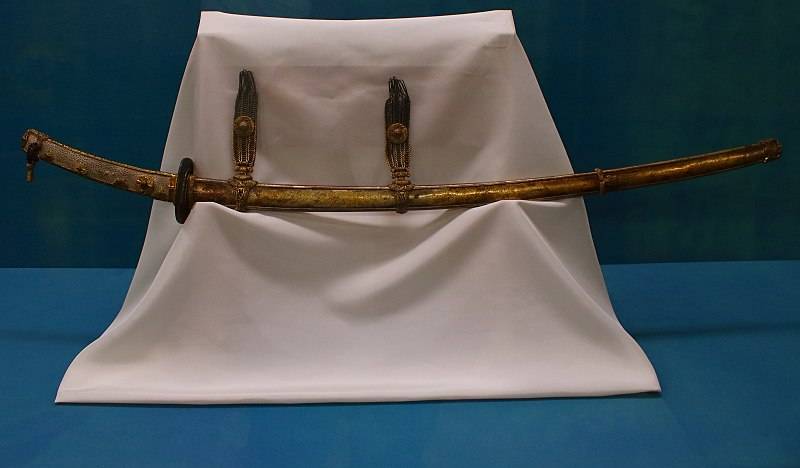
Sword of Tati, set in the style of hoogokurasi-no-tati. (Tokyo National Museum)
In Europe, shrines were placed in the handles of swords: “angel's hair”, “the tooth of John the Baptist” or “the nail of the life-giving Cross of the Lord”. But they were worshiped, and the sword only played the role of the "ark." The Japanese, being Shintoists, believed that the world was inhabited by kami spirits. And each sword has its own kami! Accordingly, the master of the sword, too, sooner or later became kami and lived in his sword, therefore the sword should be treated very respectfully, for it was the "house of the spirits."
Blade of the sword tati master Nagamitsu. (Tokyo National Museum)
Now let's turn to the historiography of the subject, that is, to the basis of the foundations.
Perhaps the first author to turn to the military stories samurai in the USSR, was AB Spevakovsky, who published the book Samurai — The Military Class of Japan in 1981 (Moscow, Main editorial board of Oriental literature of Science). The book is very interesting, although with respect to weapons there is a lot of inaccuracies. An exceptional role in the study of Japanese weapons, starting from the 90s of the last century, in our country is played by the works of K.S. Nosova, who himself is engaged in martial arts with Japanese weapons, is a doctor of science and publishes his books not only here, but also abroad. The last of his books on this topic is The Samurai Weapon (2016).
The blade of the sword tati master Sucezane. (Tokyo National Museum)
Peru A. Bazhenov owned the monograph “The History of the Japanese Sword” (2001, “Baltika / Entente”), which 15 has collected for her material for years in the collections of the Moscow Kremlin Armory Museum, the Military History Museum of Artillery, Engineers and Communications (VIMAIVVS), The Central Naval Museum (TsVMM), he owns the art of forging, and which has been invited many times by the leading museums of the country to compile catalogs of Japanese weapons. This is a very solid study that is hard to add.
Tati masters Tomonari from the province of Bitzen, XI century. (Tokyo National Museum)
The narrower themes of the Japanese sword are devoted to the work of E. Skralivetsky “Tsuba. Legends on Metal ”(2006),“ Kozuka. A small satellite of the Japanese sword ”(2009), published by the Atlant Publishing House.
Tati master Sizu Kanadzhi, XIV century. (Tokyo National Museum)
About Japanese swords is described in the translated book of the Japanese historian M. Kure “Samurai. Illustrated history ”((Trans. From English. U. Saptsinoy). M .: AST: Astrel, 2007), and there are also given their interesting photos. English historians Thomas Richardson and Anthony Bryant wrote about Japanese swords (their books in Russian can be found on the Web). But there are English-language works that have not been translated into Russian. For example, Clements J. Medieval Swordsmanship. Illustrated Methods and Techniques. Boulder USA. Paladin Press, 1998. True, the theme of the Japanese sword in this work is not the main one, but comparative information is given. Even D. Nicolas in his fundamental research: Nicolle D. Arms and Armor of the Crusading Era, 1050 - 1350. UK L .: Greenhill Books. Vol.1,2, it is written about them, although a little.
Well, and of course, mention should be made of the books of Stephen Turnbull, published in our translation in large editions and summarized in the 696-page edition of Samurai. Military history of Japan "(M .: Eksmo, 2013). True, he too has a "talkative" style of presentation and in the captions under the photographs their source and current location are not indicated. For example, how do you like this signature - "From the scroll in Yosidzaki." And where is this scroll located and how can I look at it myself? Alas, this is an obvious lack of a modern historical school, and not only a foreign one — there some authors already write under photos even this way: the source is Flicr, but also our domestic science and historical journalism.
That is, today, for those who would like to study the Japanese sword (well, at least for the sake of interest, in order not to fall into dementia before time) all the conditions and the mass of all kinds of literature exist. Unfortunately, not always in our country in the same museums conditions are created for the work of researchers of the same Japanese swords that are kept in their back rooms. I know the museum, which houses a unique Japanese parade sword with a scabbard and a handle of cloisonne enamel (!). But ... how to shoot it so as to present in all its glory? This is both difficult and expensive. I know museums where the same Bazhenov will never be invited, and where there are interesting swords that can be said to be lost for research.
The blade of the katan sword of the work of the renowned master Muramas, XV century. (Tokyo National Museum)
Konstantin Nosov in his work on the armament of samurai indicates that there are four typologies of Japanese swords, based on their chronology. And in all classifications the years are different. But most researchers distinguish as the most ancient “era of the ancient sword” - jokoto, up to about 795 - 900. Then comes the koto - the era of "old swords" - 795 - 1596. (900 - 1530), then Shinto - "New Swords" - 1596 - 1624 (or 1596 - 1781), followed by a period of synsinto - "new swords" - 1624 - 1876. (or 1781 - 1876). The year 1876, by the way, was not chosen by chance. This year, their wearing was forbidden in Japan, but the history of the Japanese sword did not end there, and a new period began - gendaito - the “newest swords” and bishyakuto - the “modern swords” made by today's masters.
Katana by Masamune with gold inscription. Kamakura, 14th century, length 70.8, see. (Tokyo National Museum)
However, all researchers are unanimous in that the ancient swords of the period of the jokoto had a straight single-blade blade and a hilt for one hand. Swords were thin, somewhat tapering to the point and with pommel, changing from century to century. Garda as such was absent. It is possible that some part of them, found in Japan, was brought from China, well, and the fact that there was a copying of Chinese samples - undoubtedly.
Then came the tsurugi swords or ken, which had a double-sided sharpening, diamond-shaped blade section. The length of his swords ranged from 60 to 70 cm.
Then in the Heian era (794 - 1191), when endless internecine wars began and the samurai caste appeared, curved swords gradually replaced direct swords, and it is known that these swords, called tati, had blades up to 120 cm.
At the same time there was a significant improvement in the blacksmith's craft. True, this can only be judged by a few rare specimens, including the swords of the beginning of the Heian era. They had a nearly symmetrical double-edged point, typical for ken swords, but they had already curved single-blade blades. The Japanese call this form "Kissaki Moroha-zukuri", "Kogarasu-Maru" or "Kogarasu-Zukuri". The name of the blacksmith Yasadzun, who is considered the father of the “typical Japanese” sword and who worked around the 900 year, is known.
Kosi-gatan with a cog in the sheath. The era of Nambokuto-Muromachi, XIV - XV centuries. (Tokyo National Museum)
In 1868, the emperor Meiji stripped the shogun of executive power and began to rule independently. Innovations borrowed from European culture began to be introduced in the country. Well, when 1876, the samurai, were deprived of the right to wear their swords, a bad time came for blacksmiths, many of whom had lost their jobs. Swords were no longer valued as they were valued in the past, and the Japanese simply sold a very large number of them abroad.
During the Showa period (1926 - 1989) under the slogan "Showa" ("Enlightened World"). The Japanese began to gradually return to the old traditions in culture and the art of blacksmith armourers revived again. Well, in recent decades, their craft is experiencing a clear flowering. Both in Europe and in the USA it became fashionable to collect Japanese swords and learn how to own them, and even collecting tsubes turned into a very common hobby, if not to the craze. Suffice it to recall that souvenir Japanese swords can be found in almost every Russian gift or souvenir shop. True, these are “not exactly swords” and even not swords at all, however the trend itself is very indicative.
Here we meet with one very important difference between a European sword and a Japanese sword. In the European blade shank, passed through the handle, was riveted, which made it impossible to replace the handle, crosshairs and finishes. That is, such a replacement required reworking the entire sword. Swords that are outdated from a military or aesthetic point of view were usually reforged, or they were deposited in chapels or monasteries. In particular, it was in one of the chapels that the legendary Jeanne d'Arc acquired a sword with three crosses on the blade, about which people immediately began to say that this is the very sword with which Karl Martell beat the Arabs at Poitiers. The sword had to be cleaned of rust and re-polished, as well as attach a new handle to it. That is, this sword was clearly kept improperly.
Tanto master Sadayoshi. (Tokyo National Museum)
Nothing like this could happen with a Japanese sword. The fact is that all his mounts on the blade are removable. Replacing them is very easy. That is, the blade can be adjusted to the requirements of any fashion, although it itself will remain unchanged! At various times, there were many varieties of the rim of the sword, many of which were even regulated by the orders of the shogun himself. That is, again, all the swords of the samurai of the Heian epoch and the subsequent time were the swords of horsemen - that is, tati, and they were worn on the left thigh with a blade down on the cords. Fasteners for cords (or belts) were only two. The frame was determined by the status of the samurai. For example, the commanders had sirizzaya-no-tachi swords, with a scabbard, two-thirds covered with the skin of a tiger or a boar.
Tanto masters Ishida Sadamune. (Tokyo National Museum)
So the rim of the sword also allows you to determine the time of manufacture of the blade, but the main thing - what is written on his shank, where the master usually beat out his name. The main ways to mount rim six. But the most common is the buke-zukuri mount of the Shinto epoch, which was now worn, thrusting them in a belt, and not on its side on cords. The buke-zukuri sword had the following setting:
• A wooden handle covered with stingray skin, connected by a bamboo hairpin (not a rivet!) with a flat shank and usually (and only sometimes with a tanto dagger) wrapped in cords (silk, leather or cotton).
• A cap for the head of the handle (kasira) and a ring for its fastening (futi).
• Additional handle decorations (menuki) - small figures - inserted into the handle braid or attached to it without braid.
• Garda (tsuba). Actually, this is not a guard at all, but quite the contrary - an emphasis for the hand so that it does not slip onto the blade.
• Scabbards - saya (most often they were made of magnolia wood, but bone ones are also known) lacquered and usually decorated with inlay. It was also customary to provide a scabbard with a "capacity" for three items not found in European swords:
• additional knife (ko-gatana); which could be used as a universal or throwing one (in Western literature, the term “kozuka” is used to designate it, but in fact, a kozuka is just a ko-gatana handle);
• pin (kogai); which could perform a variety of functions: serve as a hairpin and ... to stick it into the body of a killed enemy or into a severed head, and by this very notify whose “trophy” it is;
• chopsticks (wari-basi); however, not wooden, but metal; they correspond in shape to the kogai, but are separated along.
The handles of all these accessories protrude from the holes in the foot and pass through the holes in the tube. In Europe in the late Middle Ages, cases with accessories were also often attached, including a knife. So there is definitely a similarity here.
Wakidzasi masters Ishida Sadamune. (Tokyo National Museum)
It is necessary to note the difference between the European sword and the Japanese one, that the latter had more ornate metal parts of the mount, such as a cap of the head, a fastening ring of the handle, lining on the handle and a tsuba (in theory it would not be necessary to incline these Japanese words adhere to the norms of the Russian language than the Japanese!), as well as to whom and ko-gatan. Of course, very simple to finish swords are known in Japan. However, European as a whole they still lose. The decorations of the Japanese sword were kept in the same style, and the same master made them (except for the blade of the co-gatana who was forged by the blacksmith-gunsmith, which the blade itself did). Usually used alloy of copper and gold (syakudo), which is then blackened by etching. It is clear that a large area of a tsuba made it possible to create a small masterpiece from it, and it is not surprising that real jewelers worked on them, and now it is a separate branch of collecting.
Another short Wakizashi sword from the Tokyo National Museum.
The entire mount of the Japanese sword was designed so that it is easily disassembled. Therefore, if necessary, any renowned blade could be decorated with fashionable ornaments or, on the contrary, disguised. It is not surprising, therefore, that very old blades could often have a new mount. Well, if the sword was not supposed to be worn, the mount was removed from it and replaced with a special mount specifically for storage. That is why the Japanese swords, or rather their blades, are still in such good preservation.
To be continued ...
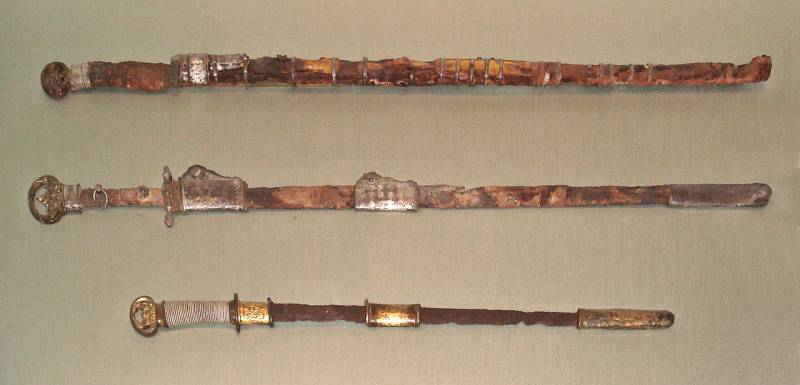
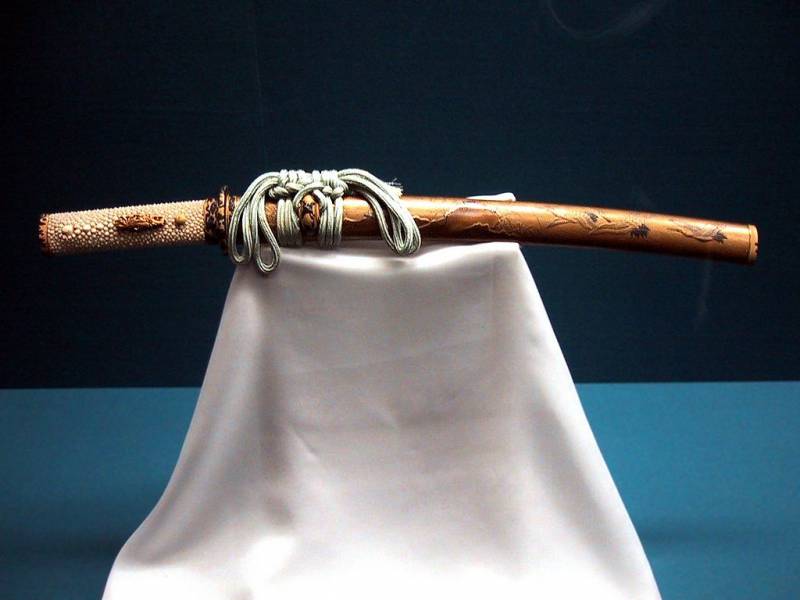
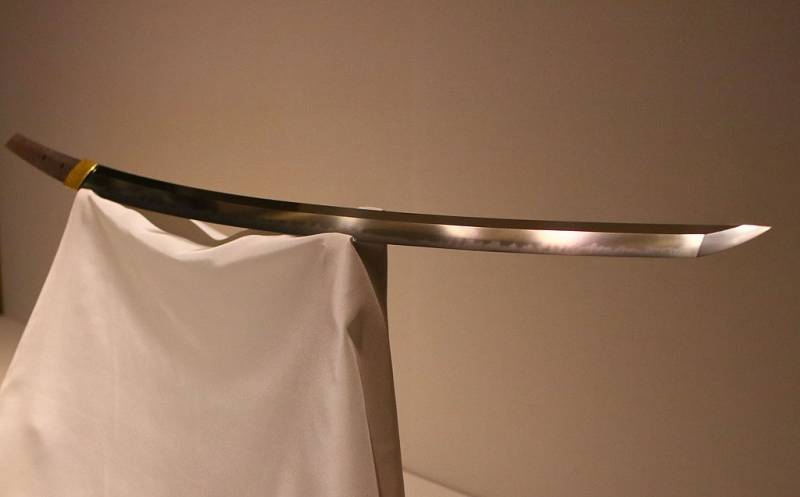
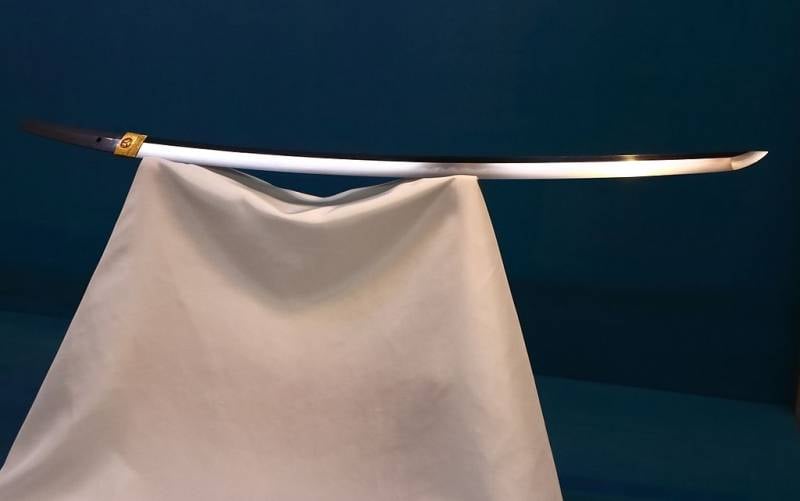
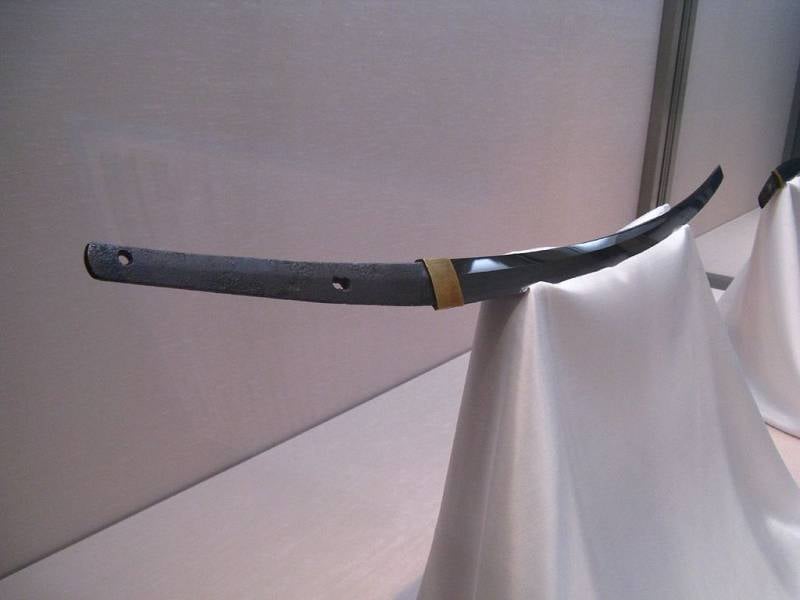



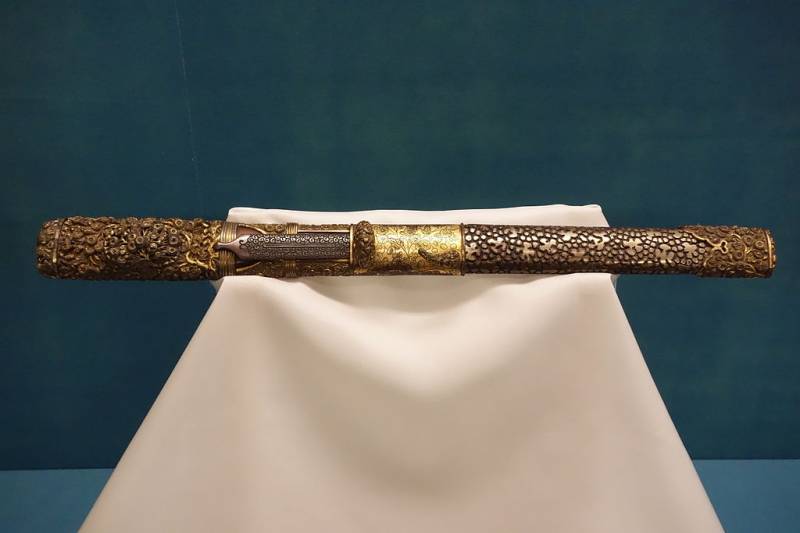
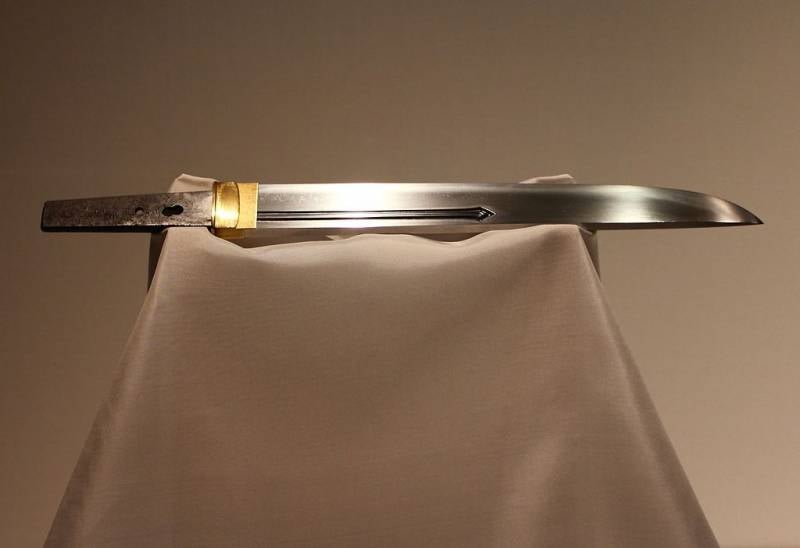
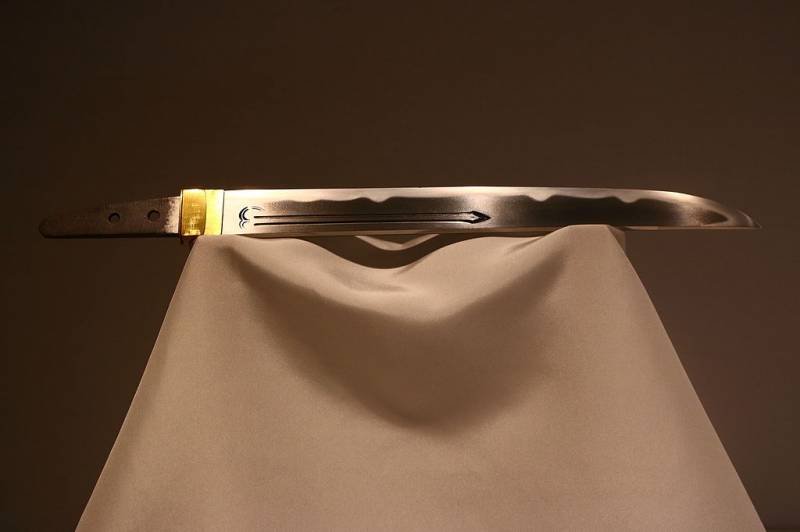
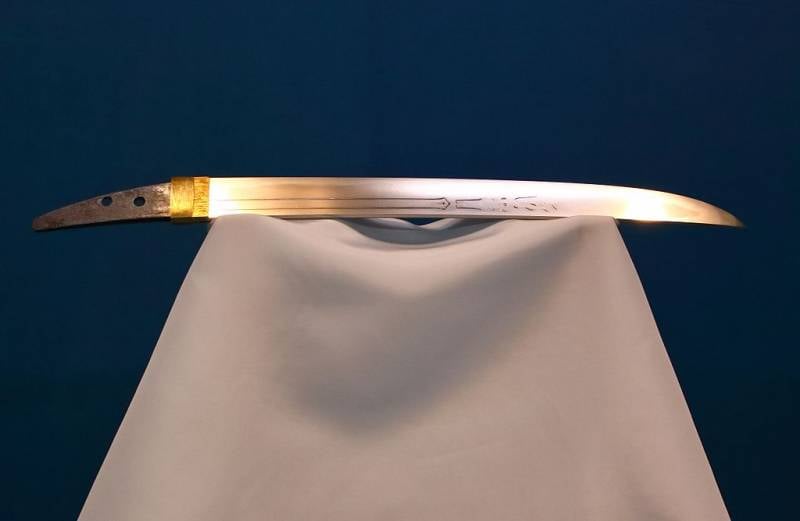
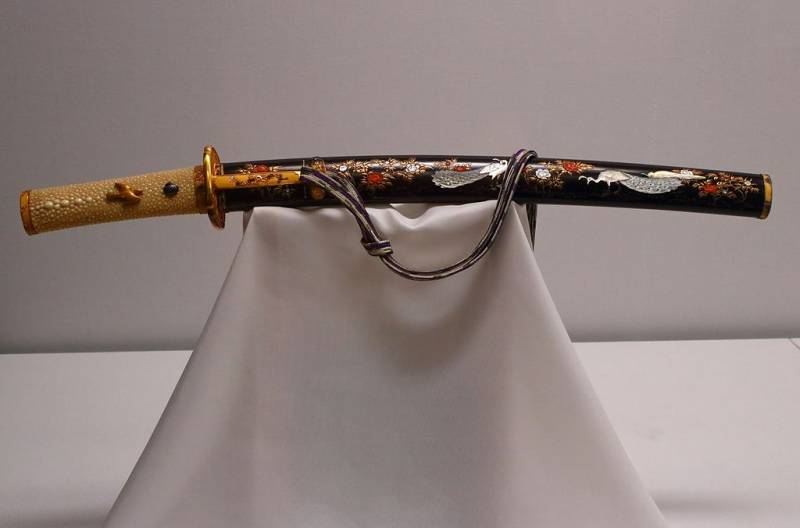
Information